From Perfume to Smoke: Transforming Salubrious Scents in a Renaissance Perfume Burner
by Madison Clyburn
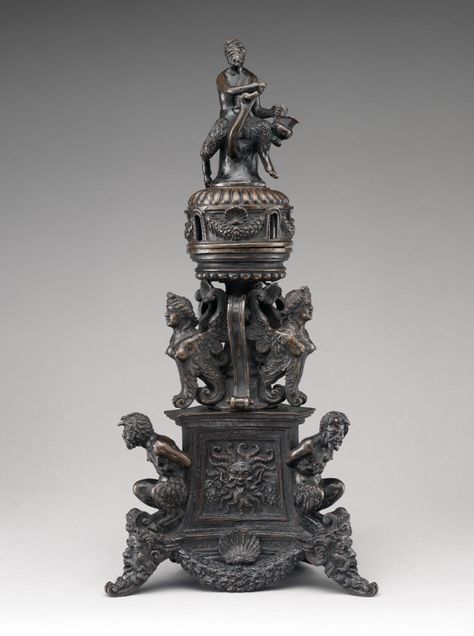
A classically inspired bronze incense burner from a Paduan workshop, now in the Metropolitan Museum of Art in New York City, speaks to the multi-sensory meditations that once occurred in an early modern Italian home (fig. 1).1 This particular incense burner measures just over a foot tall, is pyramidal in shape, and is comprised of four different parts: base, central column, drum, and finial (fig. 2).2

Like rising perfumed smoke, the decoration is aligned vertically and its fantastical satyrs, sphinxes, grotesque masks, and scalloped shells invoke Bacchic theatricality. The incense burner’s form and iconography derive from the famed Italian sculptor Andrea Riccio’s (ca. 1470–1532) humanistically informed Paschal Candelabrum (1507–16), made for the Basilica of Saint Anthony in Padua.3 Such erudite iconography was popular in Padua—a city celebrated in the sixteenth century for its humanist culture, bronze production, and medical university.
The transformation of a solid perfume into smoke through the application of fire had a multi-dimensional effect on the Renaissance home and body. In the early modern period, scented air was critical to maintaining good health; the affective, ephemeral substance, infused with the divine power of plants, drifted through city streets and infiltrated domestic halls and bodies, influencing the health of those living in Padua.4 Today, this incense burner is admired solely as an art object, devoid of its once fragrant social life. Centuries earlier, though, one would likely find it in a home, infusing a camera (multipurpose bedroom) or studiolo (study) with salubrious scents.5 Within such a space, the Renaissance user would place dried perfume (sticks or pastilles) in the incense burner’s internal compartment or external apertures and set them aflame. The resulting embers would subsequently release energizing swirls of aromatic smoke while tossing delicate light across the bronze surface, encouraging the scholar to meditate on the dramatic transformation unfolding before them. This once-fragrant object—truly a feast for the senses—exemplifies the Renaissance humanist’s philosophical interests, urban lifestyle, and desire for good health.
The New York incense burner’s iconographic pattern mirrors the humanist antiquarian’s interest in the philological and archaeological evidence of the classical past.6 From the bound and rugged satyrs to the wise and alluring sphinxes, these creatures blur the line between coarse animal and cultivated human, philosophically questioning an individual’s true nature.7 The hybrid imagery encourages the owner’s contemplation of the concept of transformation—an idea made vividly real by the metamorphizing act of burning a solid pastille or incense stick into smoke. The transient, sweet-smelling vapor that would curl up and around the burner, together with the object’s iconographical design, conjure a multi-sensorial fantasy appealing to upper-class consumers residing in sixteenth-century Padua.8
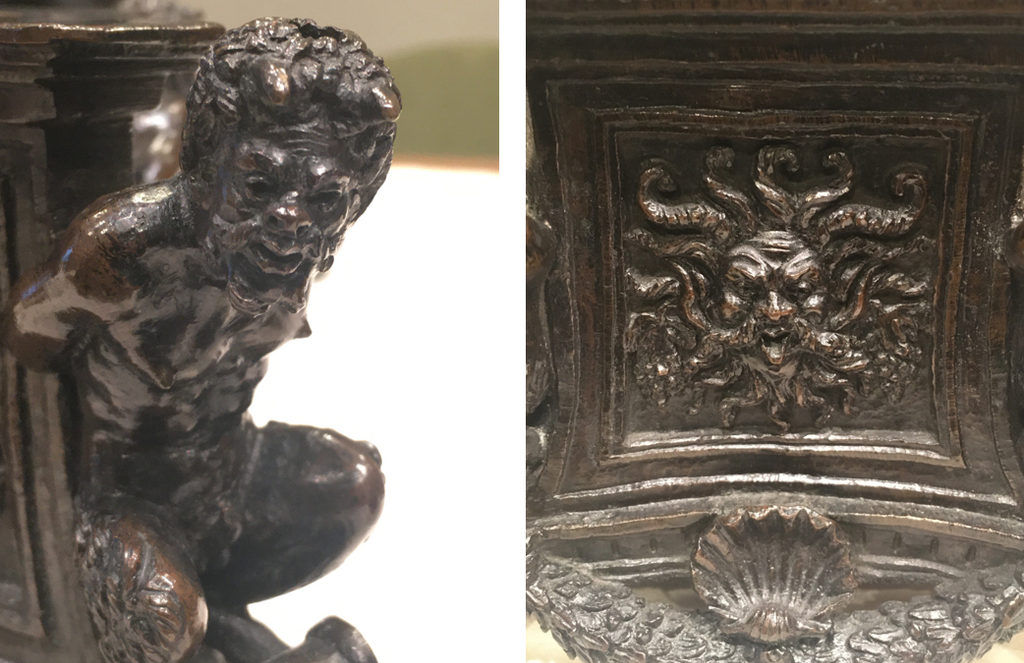
Attached to the corners of the base are feet made from satyr masks surmounted by a bound satyr (fig. 3). In his Sileni of Alcibiades (1515), the Dutch humanist Erasmus (ca. 1468?–1536) deviates from the satyr’s classical association with lust and mischief.9 Instead, he argues that if the satyr Silenus is “opened,” that is, his divinely interior self is unbound, he reveals his “great and lofty spirit worthy of a true philosopher.”10 Three decorative plaques alternate between the satyrs’ bound spirits; each one depicts a classicizing Bacchic mask with deeply set forehead wrinkles, wild, twisting hair, and a curled tongue flanked by bunches of grapes, signaling its relation to the fantastical concept of the grotesque (fig. 4).11 Meanwhile, the bordering fruit marks the transformation of grapes to wine but also from sobriety to drunkenness.12 This transition allows one to access the permeable state of divine “madness,” described by the priest and Neoplatonist philosopher Marsilio Ficino (1433–99).13 In his commentary on Plato’s Symposium titled De amore (On Love; 1469), he meditates on the soul’s continuous rise and fall through four states: Intellect, Reason, Opinion, and Nature. Bacchus’s drunkenness, and by extension, the Renaissance humanist’s intellectual inebriation activated through meditation on the smoldering incense burner, simultaneously draws the scholar to the lower world of the senses—smell, taste, and touch—and the higher world of the mind.14 In this revelatory state, inspired by Neoplatonic philosophy, the humanist’s cerebral drunkenness illuminates his rational soul, allowing him to perceive God more closely.15

Attached to the central column are a triad of alternating volutes and winged sphinxes—classical symbols of wisdom and death—with a scalloped shell nestled between their wingtips.16 The figures recall the sphinx from the ancient Greek tragedian Sophocles’s Oedipus Rex.17 Each female hybrid’s scrolled feet unfurl into lion’s fur incised on the base and torso as lusciously layered, feathered bird wings taper into the bust and head of a woman (fig. 5).
In Renaissance architectural style, sphinxes often merge architectural forms with female bodies. In this case, the sphinxes’ lion paws are transformed into miniature volutes. Together with the full-size volutes, they figuratively support the pierced, gadrooned drum above.The third tier features a series of arched windows that allow fragrant smoke to pass through. Laurel festoons fill the space between each opening, topped in the middle with scalloped shells—classical and Christian symbols indicative of transformation and rebirth.18 Like the Greek sphinx, who challenges those she meets to a riddle on the transformation of human life, the symbolic shell may also signal the owner’s mystical journey.
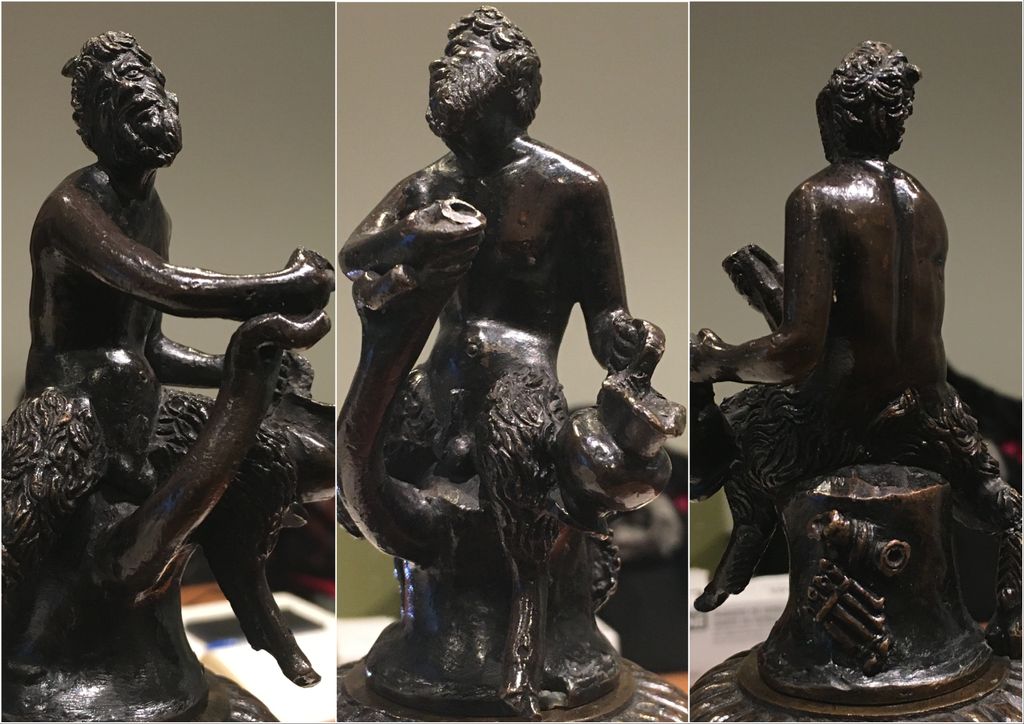
The top of the incense burner showcases a finial in the form of a satyr whose relaxed posture, vacant expression, pitcher of wine, and discarded panpipes suggest the drunken revelry of Dionysus or Pan (fig. 6). However, the satyr’s soft and elongated limbs, distinctive from those of the energetic and tightly bound satyrs at the base of the burner, suggest that this finial was made separately and added later.19 The original finial is likely a statuette of a satyr and satyress copulating like that found on a sixteenth-century Paduan inkwell cover (fig. 7).
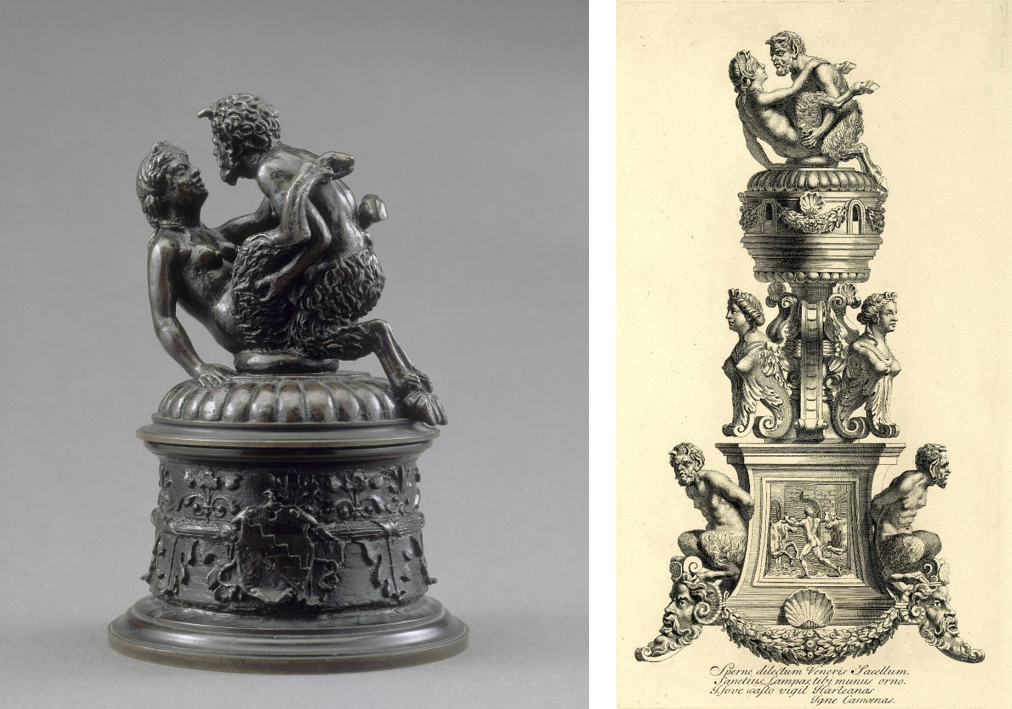
An eighteenth-century illustration of a Paduan pyramidal perfume burner (fig. 8) from the same workshop as the New York incense burner helps us imagine its original esoteric theatricality.20 The initial finial suggests the humanist scholar’s interest in philosophy and the cathartic transformation from the captive body to the unbound soul and its harmony with nature, or simply a taste for the erotic in a period saturated with amorous images of satyrs and satyresses in pastoral settings.21
Once burned, the intoxicating and energizing aroma of agarwood, benzoin, cedar, and clove-scented pastilles or sticks would waft up from the perforated heads of the bound satyrs and rising sphinxes (fig. 9) and out of the dome’s arched windows to envelope the satyrs atop the burner. The scented air continues upward, past the ambiguous but symbolically loaded finial, and up to God or a higher principle.
We must imagine—as historical audiences would have understood—the scented air eventually permeating the humanist’s porous body, sitting nearby. After entering the body, the aromatic molecules course through the scholar’s arteries and travel to the brain and heart. In doing so, scented air, facilitated through the use of a perfume burner, infuses the individual’s pneuma (air or life force) with salubrious scents to nurture the soul.22
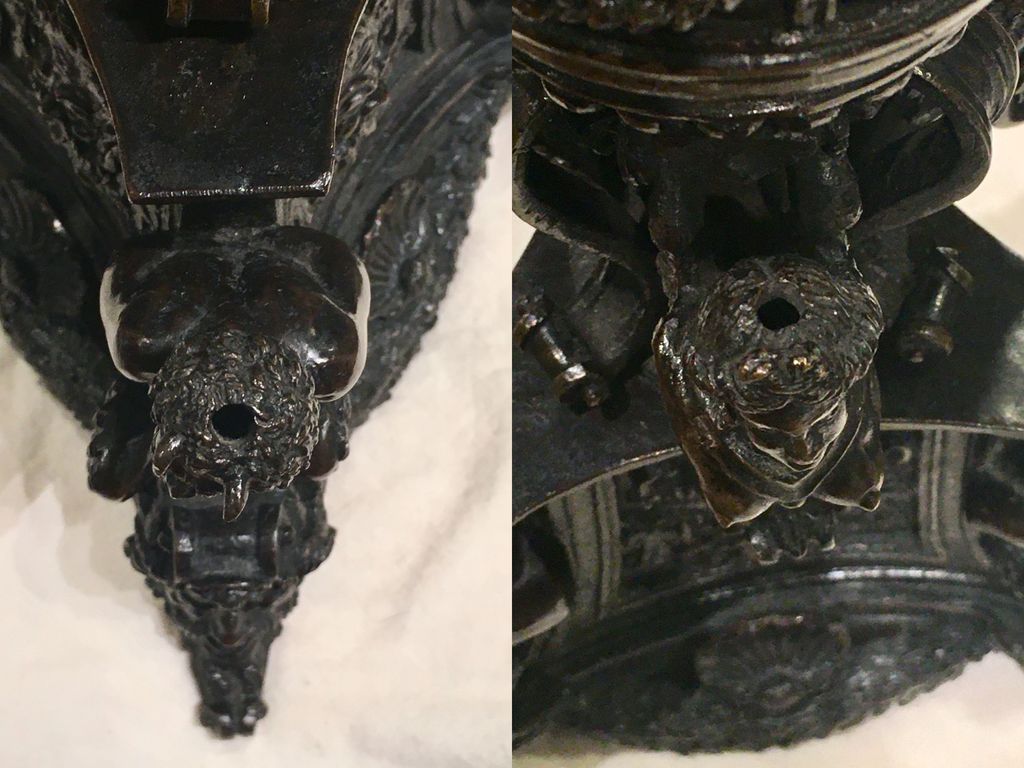
The sixteenth-century Paduan would have been cognizant of the stimulating, therapeutic effects of scent in a city teeming with students, pilgrims, rubbish, disease, and fragrant imports. Academic and economic influences from Venice and the Levant contributed to Padua’s olfactive mindfulness during this time. When our unknown maker fabricated the New York incense burner, the University of Padua (founded in 1222) was already internationally renowned as a center for medical innovation. Andrea Vesalius’s (1514–64) anatomical text, De humani corporis fabrica (1542), corresponds with the Professor of Practical Medicine, Giovanni Battista da Monte’s (1489–1551) hands-on clinical teaching and the 1595 opening of the first permanent anatomical theatre.23 In 1545, the Venetian Republic founded the first teaching botanical garden for students enrolled at the University of Padua (fig. 10).24 In this erudite atmosphere, professors combined theory and practice using translated ancient Greco-Roman and medieval Islamic texts by Aristotle, Galen, and Avicenna and specimens from the University’s botanical garden to teach about the transformative power of therapeutic scents.

Knowledge of perfumed medicines reached Padua primarily through the Republic of Venice, given its political control of the city since 1404.25 Venice—a cosmopolitan maritime center that thrived on trade relationships with Levantine mercantile partners—imported a variety of aromatics such as aloeswood, musk, civet, and ambergris from Egypt, Syria, Lebanon, and Cyprus.26 These substances were transported to nearby Padua for distribution to various institutions and vendors, allowing students and long-term residents to purchase ready-made perfumed pastilles, pastes, waters, and oils and “simples” (single ingredients) to create perfumes at home using tried-and-true recipes. A genre of books called Libri di Secreti (Books of Secrets) provided many perfume recipes to use in an incense burner, such as ones “to make a fragrant perfume to scent the house” and a “moist perfume for the room.”27 Both recipes from Giovanventura Rosetti’s Notandissimi secreti de l’arte profumatoria incorporate fragrant ingredients admired for their medicinal properties, including rosewater, aloeswood, olibanum, styrax, cloves, sandalwood, and cedar. Many recipes never made it to the printing press but existed in household manuscripts. Recipes for “soft perfumes in pans to scent rooms,” “perfumes to burn in ten ways,” and a “very noble room perfume” indicate ways to burn inspiring, transportive, salutary scents in domestic spaces.28
Surrounding oneself with sweet-smelling air was critical to maintaining or correcting one’s health—physically, spiritually, and mentally. The fortifying properties imbued in the air also played a crucial role in creating healthy, protective, and pleasant homes. The New York incense burner invites us to consider its placement among other coveted but ephemeral aromatic goods made of fragrant plant and animal-based substances complete with “personal, cultural, and social meaning” used to beautify and sanitize upper-middle-class Italian homes in the early modern period.29 For example, perfumed pastilles sheltered in bed warmers encouraged soothing sleeping quarters; floral-scented powders sewn into pillows placed on one’s lap while sewing transported them to fields of roses; while a pungent, disinfectant mix of pitch, styrax, and myrrh scrubbed over walls and floors secured dwellings against infectious air.30 Such perfumed mixtures act as transformative intermediaries capable of offering pleasure and protection. Considering this, the owner of the New York incense burner might set alight aromatic pastilles or sticks for a myriad of reasons, such as tempering the air, regulating the bodily humours, energizing the brain, fortifying the heart, stimulating sex organs, and meditating on metaphysical questions.31

Suppose we imagine a humanist scholar, like this ecclesiastic (fig. 11), sitting in his study, surrounded by books and antiquities, contemplating the philosophical text in his hand while some spiritual imbalance unsettles his humors.32 In that case, the incense burner’s presence on a shelf or desktop speaks to the myriad transformative abilities of perfume. Emblematic of a thriving academic community’s interest in wellness, sixteenth-century Paduan incense burners reflect a sensorial appreciation for tactile delights and tasteful homes mediated through perfumed air.
____________________
Madison Clyburn is an Art History PhD Candidate at McGill University. Her work focuses on medicinal perfumes and the material culture of women’s wellness in late medieval and early modern Italy. She has written for The Recipes Project, Ornamentum magazine, and the SSHRC-funded project Hidden Hands in Colonial Natural Histories.
____________________
1. Unless otherwise indicated, translations are the author’s.
The burner’s manufacture from a wax sculpture to its bronze casting is loosely attributed to Desiderio da Firenze (active Padua, 1532–45), who worked in the Veneto around the time of its creation, or an unknown Paduan workshop. Twelve variations of pyramidal and drum perfume burners produced in this Paduan workshop are located in the Metropolitan Museum of Art (invs. 41.100.78a-d and 1982.60.108); National Gallery of Art, Washington D.C. (unknown inv. number and inv. 1942.9.140); the Wallace Collection (S66); the Victoria and Albert Museum (M.677-1910); the Rijksmuseum (BK-1957-3); the Louvre (OA.7406, .8256); and the Herzog Anton Ulrich Museum, Braunschweig (unknown inv. number). Drum burners are found in the Metropolitan Museum of Art (invs. 1975.1.1396 and 1975.1.1397) and the Ashmolean Museum (WA2004.1).
2. I do not address the incense burner’s casting technique in this essay. For an analysis of the New York incense burner’s casting technique, see Madison Clyburn, Department of European Sculpture and Decorative Arts Object File (ESDA/OF), the Metropolitan Museum of Art—a study I wrote in a Bard Graduate Center seminar on bronzes held at the the Met and taught by Denise Allen, Elyse Nelson, and Jeffrey Fraiman in Spring 2020.
3. Giovanni Battista de Leone (ca. 1480–1528), Niccolò Leonico Tomeo (1456–1531), and Livio Maggi da Bassano (active 1506)—three of the five Humanists who served as massari (presiding members) on the Council of the Arca del Santo—contributed to the Paschal Candelabrum’s iconographic program, which promoted complex theological and philosophical concepts. The Candelabrum was meant to mark the first light of Christ on Easter morning. Read philosophically, the candle’s flame is akin to divine light, which “illuminates the intelligence and kindles its innate appetite at the very moment when, moved by love, it turns to God.” See Davide Banzato, “Riccio’s Humanist Circle and the Paschal Candelabrum,” in Andrea Riccio: Renaissance Master of Bronze, eds. Denise Allen and Peta Motture (The Frick Collection, 2008), 41–45, 58. For an image of Riccio’s Candelabrum, see Web Gallery of Art, https://www.wga.hu/html_m/r/riccio/candelab.html.
4. According to the proto-feminist Venetian author, Moderata Fonte (1555–92), “…God has even thought to place these [assistive] powers in plants to aid us in our infirmities. How grateful we should be!” See Moderata Fonte, The Worth of Women, ed. and trans. Virginia Cox (The University of Chicago Press, 1997), 168 for the complete passage. On the importance of “healthy” air, see Sandra Cavallo and Tessa Storey, Healthy Living in Late Renaissance Italy (Oxford University Press, 2013), especially “Chapter 3: Worrying About Air,” 70–112.
5. The studiolo had many functions in sixteenth-century Italy: it was a room for reading, writing, introspection, sociability, business, and diplomacy but also a curated space that functioned as the “innermost secret chamber of an individual’s personal world”; see Chriscinda Henry, Playful Pictures: Art, Leisure, and Entertainment in the Venetian Renaissance Home (Penn State University Press, 2021), 43. On the relationship between an individual’s studiolo, their possessions, and mental stimulation, see Stephen Campbell, The Cabinet of Eros: Renaissance Mythological Painting and the Studiolo of Isabella d’Este (Yale University Press, 2004), 31–32.
6. Robert Weiss, The Renaissance Discovery of Classical Antiquity (Basil Blackwell, 1988), 59.
7. Jessica Hughes, “Dissecting the Classical Hybrid,” in Body Parts and Bodies Whole, eds. Katharina Rebay-Salisbury, Marie Louise Stig Sørensen, and Jessica Hughes (Oxbow Books, 2010), 109.
8. While many of these tabletop perfume burners were used in Northern Italian homes, international students and tourists from England, France, Germany, and Poland (to name a few locations) likely purchased similar burners to take back to their home countries. On the demand for small, luxury, utilitarian bronzes that decorated upper-class homes in sixteenth-century Italy, see Denise Allen and Peta Motture, eds., Andrea Riccio: Renaissance Master of Bronze (The Frick Collection, 2008) and Peta Motture, The Culture of Bronze: Making and Meaning in Italian Renaissance Sculpture (V&A Publishing, 2019).
9. Ovid offers a more traditional account of the satyr in his Metamorphoses, describing “old Silenus, drunk, unsteady on his staff; jolting so rough on his small back-bent ass,” amid a Bacchanal. Ov., Met. 4.1.
10. Italics mine. Erasmus, “Adages: 1 Sileni Alcibiadis / The Sileni of Alcibiades – 100 Intersecta musica / The music is cut off,” in Collected Works of Erasmus: Adages: II vii 1 to III iii 100, trans. R.A.B. Mynors (University of Toronto Press, 1992), 263. For the satyr’s various meanings in early modern humanist culture, see Anthony Parr, “Time and the Satyr,” Huntington Library Quarterly 68, no. 3 (2005): 451–53.
11. For an overview of the concept of the grotesque in early modern Italy, see Alessandra Zamperini, Ornament and the Grotesque: Fantastical Decoration from Antiquity to Art Nouveau (Thames & Hudson, 2008). On the metamorphizing aspect of the grotesque, see Luke Morgan, “The Grotesque and the Monstrous,” in The Monster in the Garden: The Grotesque and the Gigantic in Renaissance Landscape Design (University of Pennsylvania Press, 2016).
12. For Bacchus’s role in early modern philosophical conceptions of drunkenness, see Charles H. Carman, “Michelangelo’s ‘Bacchus’ and Divine Frenzy,” Notes in the History of Art 2, no. 4 (Summer 1983): 8, and Florence M. Weinberg, The Wine & the Will: Rabelais’s Bacchic Christianity (Wayne State University Press, 1972), 45–52.
13. Marsilio Ficino, Commentary on Plato’s Symposium on Love, trans. Sears Jayne (Spring Publications, 1985), 168–71.
14. The Italian humanist philosopher, Giovanni Pico della Mirandola (1463–94), influenced by Neoplatonic theories of metaphysical unity and the Soul, suggests that Bacchus, the “leader of the muses, in his own mysteries, that is, in the visible signs of nature, will show the invisible things of God to us as we philosophize, and will make us drunk with the abundance of the house of God.” See Pico della Mirandola, On the Dignity of Man, trans. Charles Glenn Wallis (Hackett Publishing, 1965), 13–14.
15. In the fifteenth and sixteenth centuries, Platonism and Neoplatonism influenced humanist thought, art, music, and literature, especially through the concept of Beauty. The contemplation of Beauty stimulates the soul’s transcendence through the material world to achieve revelation in a spiritual one. See, Umberto Eco, History of Beauty, trans. Alastair McEwen (Rizzoli, 2005), 48–51, 90 and Paolo Euron, Plotinus, Neo-Platonic and Christian Conception of Beauty (Brill, 2019), 25–28, 41–45.
16. Yuan Yuan, The Riddling Between Oedipus and the Sphinx: Ontology, Hauntology, and Heterologies of the Grotesque (University Press of America, 2016), 51–52. On the sphinx motif in Northern Italian bronzes, see Charles Avery, “The Riddle of the Sphinxes,” in Il Bresciano Bronze Caster of Renaissance Venice (1524/25-1573) (Phillip Wilson Publishers, 2020).
17. The earliest extant version of the story is found in the Greek scholar Athenaeus of Naucratis’s Deipnosophists (c. 200 CE). The riddle goes: “On earth there is a two-footed and four-footed creature, whose voice is one. / It is also three-footed. It alone changes its nature of all the creatures / Who move creeping along the earth, through the sky or on the sea, / But when it walks relying on the most feet, / That is when the speed in its limbs is most feeble.” Sophocles, Oedipus Rex, trans. David Mulroy (University of Wisconsin Press, 2011), 91–92.
18. Shells’ association with a “mystical journey” derives from ancient Greek and medieval Christian narratives. In the classical tradition, shells signify Venus’s birth from the sea and subsequent transport to land via a scallop shell. In Christian practice, scallop shells have long been used as pilgrim badges to represent a pilgrim’s physical and spiritual journey. See, Rebekah Compton, Venus and the Arts of Love in Renaissance Florence (Cambridge University Press, 2021), 215-216, and Ann Marie Rasmussen, Medieval Badges: Their Wearers and Their Worlds (University of Pennsylvania Press, 2021), 123–126.
19. Without X-ray fluorescent (XRF) testing on the entire incense burner, we cannot determine if the bronze’s metal content is uniform or different in each of the four parts, preventing a definitive answer as to its homogenous manufacture. See Robert H. Tykot, “Investigating Ancient “Bronzes”: Non-Destructive Analysis of Copper-Based Alloys,” in Artistry in Bronze: The Greeks and Their Legacy (XIXth International Congress on Ancient Bronzes), ed. Jens M. Daehner, Kenneth Lapatin, and Ambra Spinelli (The J. Paul Getty Museum and Getty Conservation Institute, 2017), 289–299.
20. Nineteenth-century European cultural modesty led to the hasty creation of more decorous finials. For an explanation on the finial’s offensive iconography and replacement, see Jeremy Warren, The Wallace Collection Catalogue of Italian Sculpture: Volume One (Paul Holberton Publishing, 2016), 294–95; Tilmann Buddensieg, “Die Ziege Amalthea von Riccio und Falconetto,” Jahrbuch der Berliner Museen (1963): 148–50; Bernard de Montfaucon, Supplément au livre de l’antiquité expliquée et representee en figures Vol. I (Paris, 1724), 139–41. For a drawing of the original finial with smoke emanating from the top in a similar dome-shaped perfume burner, see “Drawing of a perfume burner, sent from Hamburg to the abbé de Montfaucon in Paris in 1718,” (Cabinet des Médailles, Bibliothèque Nationale, Paris; photo Bertrand Jestaz) reproduced in Jeremy Warren, Medieval and Renaissance Sculpture in the Ashmolean Museum: Volume 1 Sculpture in Metal (Ashmolean Museum Publications, 2014), 202.
21. On the production and dissemination of erotic imagery in sixteenth-century Italy, see Sara F. Matthews-Grieco, “Satyrs and Sausages: Erotic Strategies and the Print Market in Cinquecento Italy,” in Erotic Cultures of Renaissance Italy, ed. Sara F. Matthews-Grieco (Ashgate, 2010), 19–60. By nature of utilitarian bronze objects’ multifunctionality, it is important to note that the original finial’s erotic imagery of a copulating couple may speak to its potential use as a therapeutic object in which prescription aphrodisiacs meant to encourage male and female fertility were burned.
22. Though Hippocrates, Plato, Aristotle, and Galen all differ to varying degrees in their beliefs on the origin and location of the soul within the body, they all agree that pneuma is a vital substance, necessary for life.
23. For more on Padua’s medical curriculum, see Jerome Bylebyl, “The School of Padua: Humanistic Medicine in the Sixteenth Century,” in Health, Medicine, and Mortality in the Sixteenth Century, ed. Charles Webster (Cambridge University Press, 1979), 344–45.
24. By the end of the sixteenth century, the University’s botanical garden contained more than one thousand species of medicinal and non-medicinal plants. See Elsa M. Cappelletti, “The Botanic Garden of the University of Padua 1545-1995,” Botanic Gardens Conservation News 2, no. 4 (1994): 23–6.
25. After the War of the League of Cambrai (1509–17), the Republic of Venice effectively managed Padua’s educational activity. Fabio Zampieri, Alberto Zanata, Mohamed Elmaghawry, et al., “Origin and Development of Modern Medicine at the University of Padua and the Role of the ‘Serenissima’ Republic of Venice,” Global Cardiology Science and Practice no. 2 (2013): 151.
26. Leah Clark, “From the Silk Roads to the Court Apothecary: Aromatics and Receptacles,” in Courtly Mediators: Transcultural Objects between Renaissance Italy and the Islamic World (Cambridge University Press, 2023), 196–262.
27. “A far profumo odorifero da profumar una casa” and “Profumo humido per camere,” in Giovanventura Rosetti, Notandissimi secreti de l’arte profumatoria… (Venice: 1555), 7, 48.
28. “Profumi Molli in Padellette per odorare le stanze” and “profumi da Abbrucciare in dieci modi,” Wellcome Collection, London, MS.485, ff. 124-6, 213-5; “Profumo camere nobilissimo,” BNCF, Florence, Palatino 915, f. 8r.
29. Paula Hohti Erichsen, Artisans, Objects, and Everyday Life in Renaissance Italy (Amsterdam University Press, 2020), 39.
30. For scented wall and floor cleaners, see Fabrizio Nevola, Street Life in Renaissance Italy (Yale University Press, 2020), 91.
31. The central tenet of Hippocrates’s humoral theory relies on balancing the four bodily fluids: blood, yellow bile, black bile, and phlegm. Humoral theory differs from Galen’s complexion theory, in which the body’s combination of heat, moisture, coldness, and dryness determines a person’s temperament—sanguine, choleric, melancholic, and phlegmatic—and overall balance tempered by food, drink, cosmetics, medicine, and air, each believed to contain degrees of hot, dry, cold, and wet. For more, see Noga Arikha, Passions and Tempers: A History of the Humours (Ecco, 2007).
32. This room’s contents—books, vases, a bronze bell and candlestick, a carved face, a figurine, and boxes, including one of medals—evoke an appreciation of the classical past. They also reveal the sitter to be an educated and cultivated man of the Church well-versed in humanist collection practices in a time where classical philosophy and Christianity co-existed. For a reanimation of this drawing using the 1586 inventory of the Venetian patrician, Francesco Duodo (1518–1592), see Dora Thornton, A Scholar in His Study: Ownership and Experience in Renaissance Italy (Yale University Press, 1997), 38.